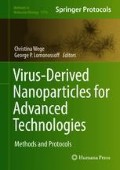Abstract
Virus-like particles (VLPs) can be used as antiviral vaccines as they mimic the structure of virus particles, with preserved conformation and immunogenicity characteristics. L1, the major capsid protein of papillomaviruses (PV) can self-assemble into VLPs currently used as highly effective vaccines. VLPs can be produced in heterologous systems, including plants. Here, a method for the expression of the L1 protein of human papillomavirus 16 (HPV 16) and the production of highly purified preparations of HPV 16 L1 VLPs is described. The method relies on the transient expression of HPV 16 L1 in Nicotiana benthamiana plants using a nonreplicating vector and on the purification of VLPs by different centrifugation steps followed by a cesium sulfate gradient. Such a procedure has also been successfully applied to other HPVs and to bovine papillomavirus 1.
Access this chapter
Tax calculation will be finalised at checkout
Purchases are for personal use only
References
Wang JW, Roden RB (2013) Virus-like particles for the prevention of human papillomavirus-associated malignancies. Expert Rev Vaccines 12:129–141
Buck CB, Cheng N, Thompson CD, Lowy DR, Steven AC, Schiller JT, Trus BL (2008) Arrangement of L2 within the papillomavirus capsid. J Virol 82:5190–5197
Baker TS, Newcomb WW, Olson NH, Cowsert LM, Olson C, Brown JC (1991) Structures of bovine and human papillomaviruses. Analysis by cryoelectron microscopy and three-dimensional image reconstruction. Biophys J 60:1445–1456
Chen X, Garcea R, Goldberg I, Casini G, Harrison SC (2000) Structure of small virus-like particles assembled from the L1 protein of human papillomavirus 16. Mol Cell 5:557–567
Buck CB, Trus BL (2012) The papillomavirus virion: a machine built to hide molecular Achilles’ heels. Adv Exp Med Biol 726:403–422
McKee SJ, Bergot AS, Leggatt GR (2015) Recent progress in vaccination against human papillomavirus-mediated cervical cancer. Rev Med Virol 1:54–71
Sohn U, Nam HG, Park DH, Kim KH (2002) Recombinant human papillomavirus vaccine expressed in transgenic plants. US patent 6,444,805
Varsani A, Williamson AL, Rose RC, Jaffer M, Rybicki EP (2003) Expression of human papillomavirus type 16 major capsid protein in transgenic Nicotiana tabacum cv. Xanthi. Arch Virol 148:1771–1786
Biemelt S, Sonnewald U, Galmbacher P, Willmitzer L, Müller M (2003) Production of human papillomavirus type 16 virus-like particles in transgenic plants. J Virol 77:9211–9220
Maclean J, Koekemoer M, Olivier AJ, Stewart D, Hitzeroth II, Rademacher T, Fischer R, Williamson AL, Rybicki EP (2007) Optimization of human papillomavirus type 16 (HPV-16) L1 expression in plants: comparison of the suitability of different HPV-16 L1 gene variants and different cell compartment localization. J Gen Virol 88:1460–1469
Regnard GL, Halley-Stott RP, Tanzer FL, Hitzeroth II, Rybicki EP (2010) High level protein expression in plants through the use of a novel autonomously replicating geminivirus shuttle vector. Plant Biotechnol J 8:38–46
Fernández-San Millán A, Ortigosa SM, Hervás-Stubbs S, Corral-Martínez P, Seguí-Simarro JM, Gaétan J, Coursaget P, Veramendi J (2008) Human papillomavirus L1 protein expressed in tobacco chloroplasts self-assembles into virus-like particles that are highly immunogenic. Plant Biotechnol J 6:427–441
Shirbaghaee Z, Bolhassani A (2015) Different applications of virus-like particles in biology and medicine:vaccination and delivery systems. Biopolymers 105:113–132
Sainsbury F, Thuenemann EC, Lomonossoff GP (2009) pEAQ: versatile expression vectors for easy and quick transient expression of heterologous proteins in plants. Plant Biotechnol J 7:682–693
Christensen ND, Dillner J, Eklund C, Carter JJ, Wipf GC, Reed CA, Cladel NM, Galloway DA (1996) Surface conformational and linear epitopes on HPV-16 and HPV-18 L1 virus-like particles as defined by monoclonal antibodies. Virology 223:174–184
Matić S, Rinaldi R, Masenga V, Noris E (2011) Efficient production of chimeric human papillomavirus 16 L1 protein bearing the M2e influenza epitope in Nicotiana benthamiana plants. BMC Biotechnol 11:106
Matić S, Masenga V, Poli A, Rinaldi R, Milne RG, Vecchiati M, Noris E (2012) Comparative analysis of recombinant human papillomavirus 8 L1 production in plants by a variety of expression systems and purification methods. Plant Biotechnol J 10:410–421
Love AJ, Chapman SN, Matic S, Noris E, Lomonossoff GP, Taliansky M (2012) In planta production of a candidate vaccine against bovine papillomavirus type 1. Planta 236:1305–1313
Thuenemann EC, Lenzi P, Love AJ, Taliansky M, Bécares M, Zuñiga S, Enjuanes L, Zahmanova GG, Minkov IN, Matić S, Noris E, Meyers A, Hattingh A, Rybicki EP, Kiselev OI, Ravin NV, Eldarov MA, Skryabin KG, Lomonossoff GP (2013) The use of transient expression systems for the rapid production of virus-like particles in plants. Curr Pharm Des 19:5564–5573
Peyret H, Lomonossoff GP (2015) When plant virology met agrobacterium: the rise of the deconstructed clones. Plant Biotechnol J 13:1121–1135
Author information
Authors and Affiliations
Corresponding author
Editor information
Editors and Affiliations
Rights and permissions
Copyright information
© 2018 Springer Science+Business Media, LLC, part of Springer Nature
About this protocol
Cite this protocol
Noris, E. (2018). Self-Assembling Plant-Derived Vaccines Against Papillomaviruses. In: Wege, C., Lomonossoff, G. (eds) Virus-Derived Nanoparticles for Advanced Technologies. Methods in Molecular Biology, vol 1776. Humana Press, New York, NY. https://doi.org/10.1007/978-1-4939-7808-3_6
Download citation
DOI: https://doi.org/10.1007/978-1-4939-7808-3_6
Published:
Publisher Name: Humana Press, New York, NY
Print ISBN: 978-1-4939-7806-9
Online ISBN: 978-1-4939-7808-3
eBook Packages: Springer Protocols

